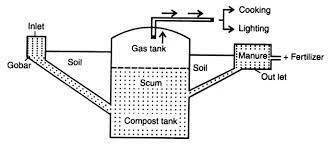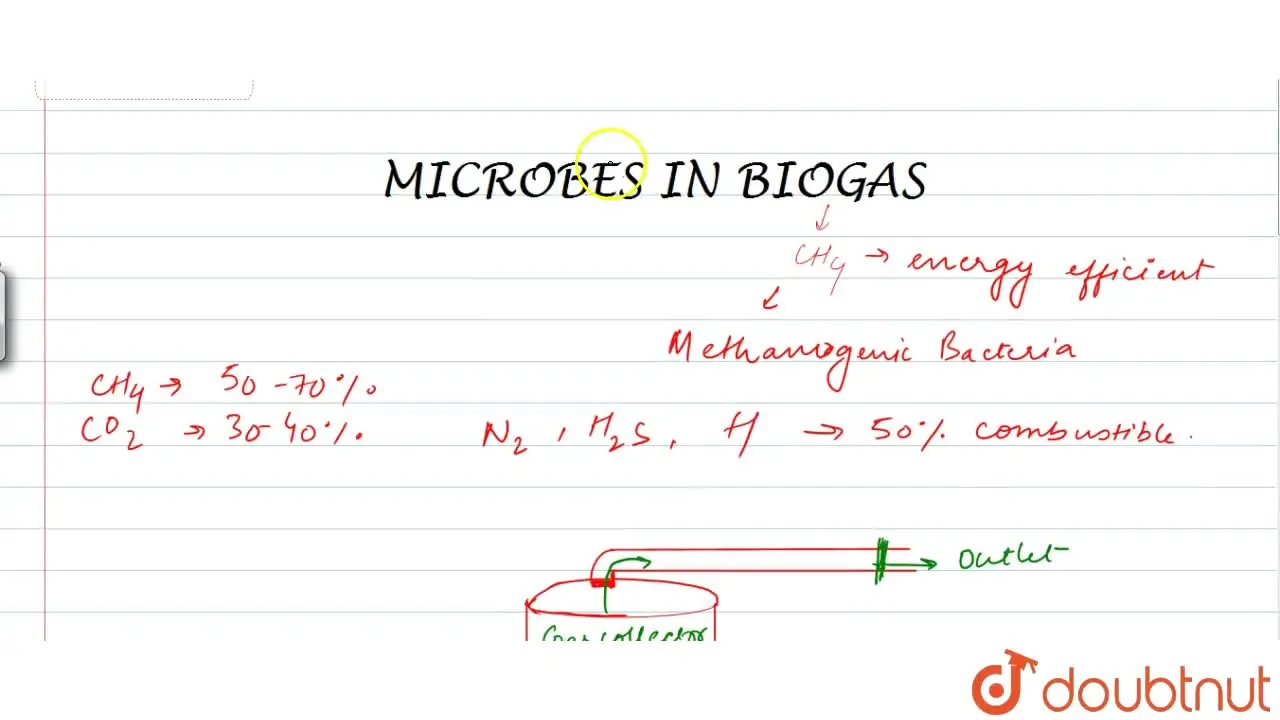Microbes In Production Of Biogas
Microbes in Production of Biogas
Biogas technology offers a substitute source of energy in rural parts of India and is hailed as a suitable technology that fulfils the basic requirement for cooking fuel in rural parts of the country. By making use of local resources that include cattle waste and other organic wastage, energy, and useful manure are produced.
Acknowledgement of this potential and the way that India supports the largest cattle prompted the advancement of the National Biogas Program in a significant manner in the late 1970s as a solution to the developing fuel crisis.
Biogas is created from natural wastes by the purposeful activity of various groups of anaerobic microscopic organisms. An endeavour has been made in this review on the work done by our scientists in understanding the microbial diversity in biogas digesters, their interactions, factors influencing biogas production, interchange feedstocks, and uses of spent slurry.
What is Biogas?
Biogas is the mixture of gases created by the microorganisms. It is a renewable source of energy. Methane is the overwhelming gas present in the biogas mixture.
Certain microscopic organisms develop under anaerobic conditions and produce a lot of methane alongside carbon dioxide and hydrogen. The microorganisms which produce the gaseous mixture are on the whole known as methanogens. Methanobacterium is an example of of methanogen.
Methanobacterium is present in the rumen of the dairy cattle and the sludge produced during the sewage treatment. The methanobacterium present in the dairy cattle feed digests the cellulose content present in the cattle food. The manure by the cattle wastes contains these methanogens which can be used for the production of biogas, also known as the gobar gas.
Cattle waste is accessible in the rural area in enormous quantities. In this way, we can discover biogas plants all the more frequently in rural areas. The biogas produced can be used for cooking and lighting purposes.
On the application of particular microbes, the waste gets converted into energy in a biogas plant.
Ecology of Biogas
Biogas is considered an environment-friendly energy source because it lessens two significant ecological problems simultaneously:
1. The global waste pandemic that releases hazardous levels of methane gas each day.
2. The dependence on fossil fuel energy to fulfil the global energy need.
By changing over natural waste into energy, biogas is reusing waste substances to convert them into productive resources. Biogas production recovers waste materials that would otherwise pollute the landfills; prevents the use of poisonous chemicals in sewage treatment plants, and saves money, energy, and material by treating local waste. In addition, biogas usage does not require fossil fuel extraction to create energy.
Biogas generation eliminates the poisonous gas by converting it into a lot safer form. All the more specifically, the methane content present in decomposing waste is changed over into carbon dioxide. Methane gas has around 20 to 30 times the heat-trapping capabilities of carbon dioxide. This means when a spoiling portion of bread converts into biogas, the portion's ecological effect will be around 10 times less intense than if it was left to decay in a landfill.
Microbial conversion of organic material to methane gas is a technique for waste treatment and resource recovery. This process is anaerobic and is done by the activity of various groups of anaerobic microscopic organisms.
Three basic points about this process of conversion of waste into methane gas are:
(i) Most of the significant microorganisms engaged with biogas production process are anaerobes and slow-growing;
(ii) A more prominent level of metabolic specialization is noted in these anaerobic microorganisms; and
(iii) Most of the free energy present in the substrate is found in the final product methane. Since less energy is accessible for the microbial growth, the less microbial biomass is produced and, consequently, disposal of sludge after the digestion may not be a significant issue.
Related Videos:
- Biogas Production
- The microorganism used in production of biogas
- Group of bacteria used in biogas production is
- Discuss the role of microbes in production of blogas
- Discuss the role of microbes in production of household products
Biogas Plant Structure
The biogas plant consists of a solid tank around 10 to 15 feet down. Bio-wastes and a slurry of compost are taken care of in this tank. A broad floating cover is set over the slurry. The floating cover keeps on rising with a steady generation of gas. An outlet takes the biogas to the house where the gas can be used for various energy needs. The spent slurry is taken out through another outlet and can be used as manure. The innovation of biogas production was created in India by Indian Agricultural Research Institute (IARI) and Khadi and Village Industries Commission (KVIC).

The biogas plant has a source inlet to supply the gobar or cattle excreta, a compost tank for biogas production, a biogas recovery unit to isolate the produced biogas, and heat exchanger to maintain the temperature of the digester.
• The biowaste and the slurry of waste are taken care of into an anaerobic digester.
• The slurry is secured with a floating cover. The gas created because of microbial action makes the cover rise upwards.
• The produced biogas is supplied to the respective places through associated pipes and can be used for cooking and lighting.
• The used slurry is evacuated through an outlet and can be used as compost later.
Biogas Production in Landfill
Biogas is also produced in the landfills aside from biogas plants. The organic material naturally decomposes inside the landfill, for example, inside a pit in the land, and biogas is produced by the movement of the microbes. The Methanobacteria decompose organic waste and produce a mixture of gases known as the biogas. There is a system of interconnected pipes in the landfill to collect the produced gas. The composition of the gas varies after a specific time span. Following a year, the composition of methane and carbon dioxide is 60% and 40% respectively. This technique is picking up popularity because of the way that it prevents the explosion caused by the collection of methane inside the landfill, and furthermore prevents the loss of methane in the atmosphere.
Advantages of Biogas
The biogas is environment-friendly. The biogas production makes the use of organic waste and converts it into energy, hence alleviating the methane gas. It happens due to the biogas combustion that eventually leads to a decrease in the emission of greenhouse gases.
1. Biogas is a safe, economical, renewable source of energy.
2. Biogas can be used for cooking purposes.
3. It can be used for domestic and street lighting.
4. It is an eco-friendly gas and does not cause harm or pollution.
5. It is also used as fuel for driving engines.
6. The slurry residue left after the biogas production can be used as manure.
Important Chapters:

Similar Questions
Discuss the role of microbes in production of blogas.
View SolutionDiscuss the role of microbes in production of household products.
View SolutionHow are microbes involved in production of biogas?
View SolutionSewage Treatment|Microbes In Bio Gas Production|Bio Gas Plant|Advantages Of Biogas
View SolutionExplain the role of methanogens in production of biogas
View SolutionName two special categories of microbas involved in production of biogas. Write composition of biogas.
View SolutionGive the role of microbes in the production of alcoholic beverages.
View SolutionWhat is the role of microbes in the production of bioactive molecules?
View SolutionBiogas Production
View SolutionMicrobes in biogas production | | Biocontrol agent
View Solution


